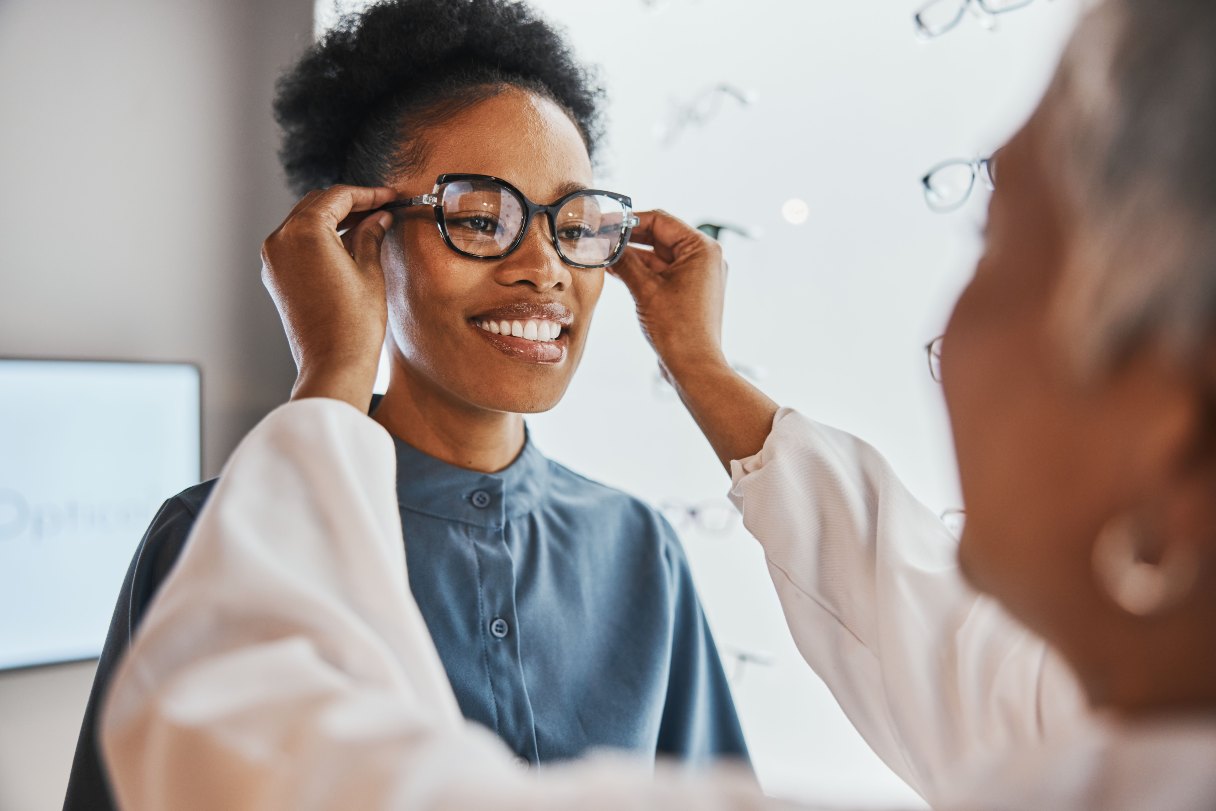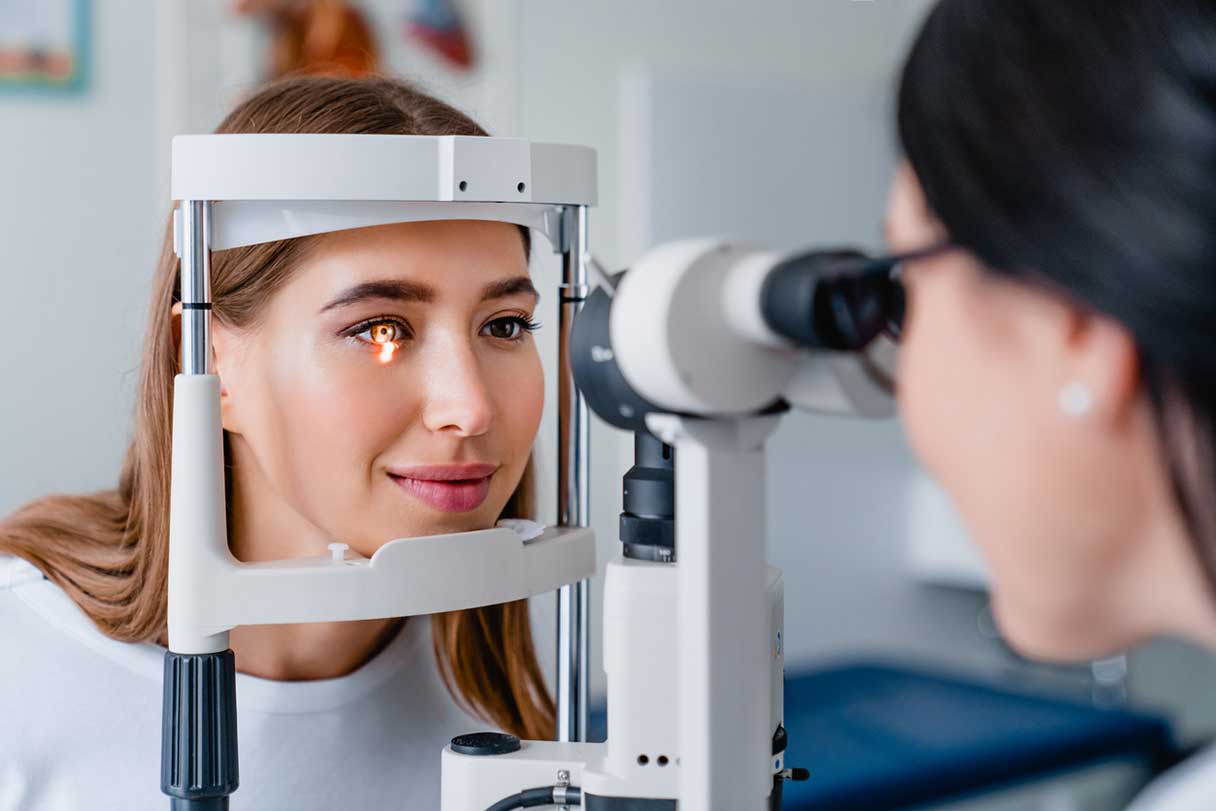Do you find yourself squinting to see something up close, or struggle to make out objects in the distance? If so, you may be dealing with one of the two most common vision issues: nearsightedness or farsightedness.
Farsightedness affects about 10% of people in the United States (approximately 14 million in total).1 Nearsightedness affects as many as 20% to 50% of people in the United States.2 If you have either of these conditions, there's no need to struggle — today's wide range of treatment options can help you see more clearly.
How to Tell if You're Nearsighted or Farsighted
Nearsightedness and farsightedness are different types of refractive errors that affect your vision. If you're nearsighted (myopia), you can see things close to you clearly, but objects farther away appear blurry. If you're farsighted (hyperopia), you'll experience the opposite. Objects at a distance are easy to focus on, but nearby objects look blurry.3
Sometimes, the shape of your eye can play a role in both vision issues. Nearsighted people typically have an elongated or oval eyeball, while farsighted people often have a cornea that's too flat or their eyeball is too short.3
Your eye doctor can help you determine exactly which refractive vision error you have so that you can find the right treatment.
Symptoms
While some vision changes may seem minor, others can make daily tasks like reading or driving more challenging. Knowing what symptoms to watch for can help you determine whether you're dealing with nearsightedness, farsightedness, or something else — and what steps to take next.
Nearsightedness symptoms
Nearsightedness occurs when light entering your eye focuses in front of your retina rather than directly on it. This happens because your eye's shape prevents your eye from focusing the light correctly.4
Symptoms of nearsightedness can include:4
- Seeing close objects clearly, while distant objects appear blurry3
- Headaches
- Squinting
- Struggling to see a movie, TV screen or whiteboard5
- Struggling to read road signs
Farsightedness symptoms
Farsightedness occurs when light entering your eye focuses behind your retina rather than directly on it. This happens because the shape of your eye or cornea prevents the light from being focused correctly.6
Some symptoms of hyperopia include:6
- Headaches
- Trouble focusing on things that are close, but items far away can be seen clearly
- Trouble reading
- Squinting
- Eyestrain
- Blurry vision at any distance for severe cases
Causes and contributing factors
Genetics can play a significant role in whether you experience nearsightedness or farsightedness, but factors like screen time, reading habits and overall eye health may also influence vision changes. Understanding what contributes to these conditions can help you make informed choices about your eye care.
What causes nearsightedness?
A few factors can contribute to developing myopia, such as:
- Genetics. Myopia can be inherited. The chance of developing myopia is much higher if one or both of your parents have it.2
- Near-vision work. Frequent close-up work for extended periods may cause accommodative fatigue.3 This means your eye is tired and has trouble refocusing on distant objects.5 While clearer vision can return, developing accommodative fatigue frequently may lead to permanent issues.5
- Too much time indoors. Your chance of developing myopia increases as a child if you don't go outside very often.4
Other environmental conditions have been suggested to contribute to myopia but haven't been proven. For example, a strong correlation has been found between higher intelligence scores and myopia, but what causes this link isn't known.2
What causes farsightedness?
Several factors can contribute to hyperopia:
- Genetics. Severe cases are typically inherited from your parents.3
- Medical conditions. Some health issues can contribute to hyperopia, such as diabetes, multiple sclerosis and thyroid problems.7
- Eye injuries or surgeries. If injuries or surgeries change your cornea's shape, they might cause hyperopia.7
Diagnosis and Treatments
An eye exam can help determine if you're nearsighted or farsighted. Your doctor will check how your eyes focus at different distances and may recommend glasses or contacts to help. There are also other options, like specialized lenses or procedures, that may help improve your vision.
Diagnosing nearsightedness
Your optometrist or ophthalmologist will diagnose nearsightedness with thorough eye exams to see how you focus light. These may include:4
- Reading letters on a chart to check your visual acuity5
- Testing different powered lenses with a phoropter to see if they improve your sight
- Using a retinoscope to measure where light is aimed inside your eye (often helps determine the prescription needed for children who can't read yet)
Your eye care provider might also rule out other conditions that can cause myopia, such as uncontrolled diabetes, Stickler syndrome, Marfan syndrome, Ehlers-Danlos syndrome, Weill-Marchesani syndrome, a developing cataract, congenital glaucoma, albinism, keratoconus and more.2
Diagnosing farsightedness
Your optometrist or ophthalmologist will diagnose you with a thorough eye exam. This may include:6
- Reading letters on an eye chart
- Using a phoropter to measure which lens prescription helps you see the best
- Using a retinoscope to measure how light is aimed in the eye (often used with children who can't read a chart yet)
When your eye doctor gives a hyperopia diagnosis, they may also rule out other conditions that can cause similar symptoms, such as presbyopia, cataracts, hypoglycemia, orbital tumors or retina elevation.1
Treating nearsightedness
There are different options for treating nearsightedness, such as:
- Glasses. For children and adolescents, you would likely consider eyeglasses rather than contacts.2 If you develop more vision issues with age and want to keep wearing glasses, you may need bifocals or trifocals, which combine multiple prescriptions in one pair of glasses.5
- Contact lenses. These are best for people adolescent age or older who are mature enough to handle the responsibility and care of contacts.2
- Overnight contacts. Also called ortho-k or corneal refractive therapy (CRT), these rigid contacts gradually reshape your cornea overnight, allowing you to go without corrective lenses during the day.5
- Laser-assisted in situ keratomileusis (LASIK). LASIK surgery involves removing a small inner layer of corneal tissue.5
- Photorefractive keratectomy (PRK) laser surgery. PRK can eliminate the need for glasses or contacts.3 It involves removing a thin layer of tissue from the surface of the cornea.5
- Radial keratotomy (RK). Used for mild nearsightedness, RK involves making tiny cuts in the cornea with a scalpel to flatten the cornea.8
- Automated lamellar keratoplasty (ALK). Used only for severe myopia, ALK involves removing a thin slice of tissue from the cornea.8
- Intracorneal rings (Intacs). This treats mild myopia by implanting thin rings in the cornea that change how it curves.8
- Clear lens extraction with intraocular lens (IOL). This procedure involves removing your natural lens and replacing it with an IOL.5 It can be used for severe myopia.9
- Phakic intraocular lens (PIOL). This involves putting a PIOL in front of your natural lens rather than removing your lens.5 It may be used for more severe myopia.9
- Vision therapy. If your myopia is caused by spasming muscles, you may be given eye exercises to help fix the issue.5
Treating farsightedness
There are different options for treating farsightedness, including:
- Glasses. Glasses are a common treatment for farsightedness in both adults and children.1 If you develop more vision issues as you age, you may need bifocals or trifocals, which combine multiple prescriptions in one pair of glasses.5
- Contact lenses. Contacts are best reserved for adults rather than children, since children may not be mature enough to handle the responsibility and care of contacts.1
- LASIK. This surgery removes a small inner layer of corneal tissue.5 It's typically recommended for milder hyperopia cases.6
- Photorefractive keratectomy (PRK) laser surgery. This involves removing a thin layer of tissue from the surface of the cornea.5 It can eliminate the need for glasses.3
- Automated lamellar keratoplasty (ALK). A deep cut is made to your cornea, causing bulging that helps improve focus.8
- Conductive keratoplasty (CK). CK treats mild to moderate hyperopia. Radio waves create heat that shrinks collagen to change the cornea's shape. Only people 40 or older can have the surgery.8
- Clear lens extraction with intraocular lens (IOL). This involves removing your natural lens and replacing it with an IOL.5
- Phakic intraocular lens (PIOL). With this, a PIOL is placed in front of your natural lens rather than removing your lens.5
Prognosis and Complications
For many people, nearsightedness and farsightedness may be easily managed with corrective lenses or other treatments. However, vision changes can continue over time, requiring updated prescriptions or additional care.
Nearsightedness prognosis
Some potential complications that are more likely with severe myopia (also called high myopia) include:4
- Cataracts
- Glaucoma
- Retinal detachment — If you have severe myopia, you should see an ophthalmologist regularly to get your retina checked.
Other less severe symptoms that adults or children might experience include headaches, eyestrain and struggling to see items at a distance.4 This could disrupt everyday activities like seeing whiteboards at school or reading road signs when driving.5
Farsightedness prognosis
Eye health is important to maintain at any age. Many children start out farsighted but may never notice any blurry vision. Over time, as their eye grows, the farsightedness might disappear.6
However, this won't happen for some children who have more severe hyperopia. In those cases, without treatment, potential complications can develop, such as:6
- Acute angle closure glaucoma1
- Amblyopia (lazy eye)
- Strabismus (crossed eyes)
Adults can also suffer complications, such as eyestrain, headaches and trouble seeing things that are up close.3 This could disrupt everyday activities like working or driving.
What Role Does Astigmatism Play?
Astigmatism happens when your cornea or lens is abnormally shaped, causing both close and far objects to appear blurry. It can occur by itself or with farsightedness or nearsightedness and may affect people of all ages and genders.7
Astigmatism is treated with glasses, contacts or surgery and can be combined with hyperopia or myopia treatments.7
Managing Nearsightedness and Farsightedness
As mentioned in detail earlier in this guide, there are extensive options for managing nearsightedness and farsightedness. Many people choose a less intrusive option, such as wearing glasses or contacts.
Others prefer a longer-lasting surgical option, such as LASIK, PRK laser surgery or radial keratotomy. Or you can choose a clear lens extraction, where your natural lens is removed and replaced with a permanent intraocular lens that corrects your vision issue.
Lowering Contributing Factors or Progression
If you or your child are nearsighted or farsighted, it's important to see your eye care provider regularly. Both vision issues can be managed with a wide array of treatments, helping improve your quality of life and the health of your eyes.
Preventing or slowing myopia
Children can lower their chance of developing myopia by spending more time outside. It's not known exactly why, but sunlight exposure appears to help. One theory is that natural light's short wavelength helps prevent eye elongation. Or simply taking more breaks from near-vision work may be curative.3
Unfortunately, there's no indication that vitamins can prevent nearsightedness.4
The following approaches can reduce the progression for children with myopia:4
- Eye drops. Low-dose atropine eye drops applied at night can reduce eye lengthening and are effective in approximately 80% of cases.
- Prescription contacts. Peripheral defocus contact lenses correct blurry distance vision at the center, while the peripherals are designed to blur a child's side vision. It's believed that blurry peripheral vision can slow the eye's growth. It's used in children ages 6 to 12.
- Orthokeratology. These hard contact lenses are worn at night and temporarily flatten the cornea.
Preventing or slowing hyperopia
Unfortunately, there isn't much you can do to lower your chance of developing hyperopia or prevent its progression, since people are typically born with it. However, you can reduce your eyestrain during close-focusing tasks like working on the computer or reading. Every 20 minutes, take a break and look at something 20 feet away for 20 seconds. This can help stop you from putting too much strain on your eyes.10
There's also no indication that vitamins or eye exercises can prevent farsightedness.6 However, deficiencies in vitamins A, B1, B12, C and others may contribute to different eye issues, so a balanced diet can keep your eyes healthier overall.11 If you're concerned about hyperopia, be sure to take care of your eyes with regular eye exams and sun protection.10
The Bottom Line
Nearsightedness and farsightedness are common issues both children and adults may face. The good news is that numerous treatments are available to help correct your vision if you have refractive errors. Just remember: These problems can develop or worsen over time, so regular appointments with your optometrist or ophthalmologist are essential.
Financing Vision Correction With the CareCredit Credit Card
Regular eye exams are an important part of your eye health. Whether you’re getting an eye exam or paying for eye surgery, the CareCredit credit card can help you pay for care where your insurance leaves off.* Use our Acceptance Locator to find a vision specialist near you that accepts CareCredit. Continue your wellness journey by downloading the CareCredit Mobile App to manage your account, find a provider on the go and easily access the Well U blog for more great articles, podcasts and videos.
In addition to vision care, you can also use your CareCredit credit card for dentistry, cosmetic, pet care, hearing, health systems, dermatology, pharmacy purchases, spa treatments and so much more within the CareCredit network. How will you invest in your health and wellness next?
Author Bio
Stephanie Dwilson specializes in science journalism, breaking news and animal health and is a business owner, non-practicing attorney and writer.







